Your browser does not fully support modern features. Please upgrade for a smoother experience.
Please note this is an old version of this entry, which may differ significantly from the current revision.
Subjects:
Materials Science, Paper & Wood
Paper, especially nanopaper, is a very promising material for the development of low-cost flexible humidity sensors suitable for a wide range of applications.
- sensor configuration
- fabrication
- paper types
1. Introduction
Lately, a new trend has appeared with the integration of sensors directly on flexible plastic foils. Their flexibility and their simplified processing, targeting the production on large area using roll to roll and printed electronics processing (see Figure 1), bring new opportunities and will also reduce several technical limitations that characterize the production processes of conventional microelectronics [1]. According to the Organic and Printed Electronics Association (OE-A) [2], in the coming years, printing technologies and printed electronics are expected to dominate in sectors such as the Internet of Things or IoT, healthcare, automotive and consumer electronics.
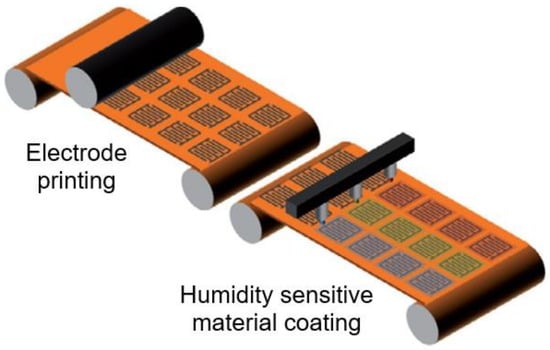
Figure 1. Schematic drawing of a roll-to-roll production line for chemical gas and humidity sensors on plastic foil. The transducers and coating layers are coated using additive printing techniques, such as the gravure printing of interdigitated electrodes and the local ink-jet printing of different sensing layers.
In conventional Si microelectronics, patterning is most often done using photolithography, in which the active material is deposited initially over the entire substrate area, and selected areas of it are removed by physical or chemical processes. Despite its high resolution, the photolithographic process is very complex, expensive, uses extremely expensive equipment, requires many steps, is time consuming, subtractive, and only suitable for patterning of small areas.
In addition, the harsh conditions required to dissolve the resists, etch the underlying layers, and remove the photoresist destroy the activity of most organic electronic materials. De Rooij and co-workers [4,5] believe that the printing technology applied in flexible electronics is experiencing a significant growth and the sensors field can benefit from these developments with the availability of new types of materials and fabrication processes. Printed electronics can be defined as the combination of printing processes and ink chemistry for the manufacturing of electronic components. Compared to the conventional lithographic processes used in microelectronics, mentioned above approach to design of gas and humidity sensor as well to biosensors and electrochemical sensors guarantees reduced price, new functionalities and possibility to integrate sensors where it was impossible to imagine them a decade ago. This approach is compatible with the new generation of electronic devices made from polymeric materials (known as organic electronic devices), which are the future of lower manufacturing costs. This opens up a wide range of applications for flexible sensors such as environmental monitoring, food quality control, medicine and industrial process control [6,7,8,9,10,11,12]. An example of a flexible humidity sensor made on plastic foil is shown in Figure 2.
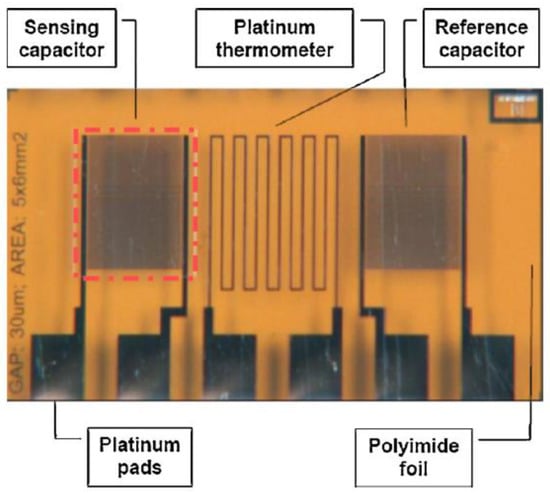
Figure 2. The sensor platform substrate with Pt thermometer, electrodes and connection pads. The interdigital electrode structures realize two plane capacitive transducers, a sensing one (left) and a reference one (right). The area reserved for the polymer sensing layer is surrounded by a dot line frame.
In addition, flexible substrates are ideal for deployment on curved surfaces, for integration on cloths for application in wearable sensors, smart textiles, or for development wireless radio frequency identification (RFID) tags for logistics applications [14]. In this case no direct optical contact is required to identify an item. It leads to higher efficiency in goods handling [15]. Plastic substrates possess also many attractive properties including biocompatibility, light weight, shock resistance, softness and transparency [16]. More detailed information on the achievements and prospects in the development of sensors on plastic foil can be read in the reviews prepared by Briand et al. [3] and Mattana and Briand [17].
Humidity sensors are among the fastest growing sensor markets. The global humidity sensor market is predicted to grow by 7.5% per year in the coming years and reach $1551.9 million by 2026 (https://www.researchdive.com/171/humidity-sensor-market, accessed on October 2022). This growth will primarily be due to the miniaturization of electronic devices and the use of humidity sensors in various industries. Due to unique water properties, humidity greatly affects living organisms, including humans and materials. The amount of water vapour in the air can affect the human comfort, and the efficiency and the safety of many manufacturing processes, including drying of products such as paint, paper, matches, fur, and leather; packaging and storage of different products such as tea, cereal, milk, and bakery items; and manufacturing of food products such as plywood, gum, abrasives, pharmaceutical powder, ceramics, printing materials, and tablets. Moreover, industries discussed above are only a small part of the industries where the humidity should be controlled. In agriculture, the measurement of humidity is important for the plantation protection (dew prevention), the soil moisture monitoring, and so on [27]. In the medical field, a humidity control should be used in respiratory equipment, sterilizers, incubators, pharmaceutical processing, and biological products. Humidity measurements on the Earth’s surface are also essential for meteorological analysis and forecasting, for climate studies, and for many special applications in hydrology, aeronautics, and environmental studies, since water vapor is a key factor in both weather and climate. Therefore, humidity control becomes mandatory in all areas of our activity, from production management to creating comfortable conditions for our living, and to understand the nature of climate change [23,24,25]. As a result, the field of application of humidity sensors is constantly expanding, requiring more and more devices with improved parameters and more adapted to new applications (Figure 3). The demand for paper-based flexible humidity sensors is caused precisely by these circumstances. In particular, in recent years, there has been a need for cheap flexible humidity sensors for applications such as breath analysis and respiration rate, diaper and skin moisture monitoring, healthcare monitoring systems, etc. [21,26,28,29,30]. Studies have shown that PB humidity sensors can be successfully used in these applications [26,28,31]. One example of such an application is shown in Figure 4. It is important to note that for such applications, humidity sensors, in addition to high sensitivity, good stability, long-term durability, rapid response and recovery time, high linearity, and exceptionally low hysteresis [18] must meet the following requirements [28]: (i) be flexible for wearables; (ii) not use toxic substances harmful to humans; (iii) be disposable to avoid cross-infection or contamination while monitoring the patient’s respiratory rate and wetting the baby diaper; (iv) have low cost and simple manufacturing technology; as well as (v) have a minimal polluting effect on the environment.
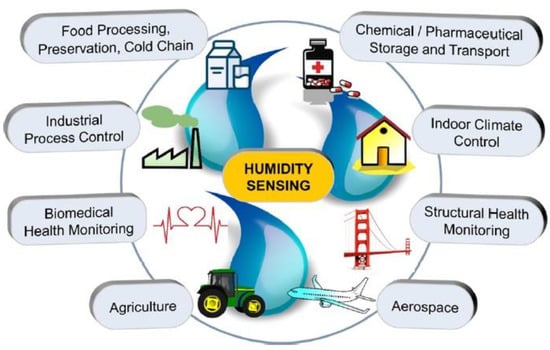
Figure 3. Various application paradigms of humidity sensors.
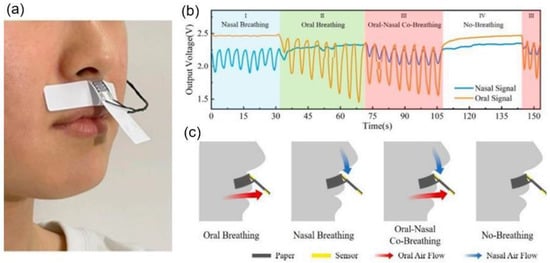
Figure 4. (a) Photo of a volunteer wearing a PB humidity sensor patch. (b) Simulated breathing experiments for different breathing modes and various respiratory patterns. (c) Schematic diagram of oral and nasal airflows in four respiratory patterns. PB humidity sensors was fabricated on printing paper. The graphite ink was screen-printed for fabrication interdigital electrode pattern. For the purpose of distinguishing between oral and nasal respiratory signals, two graphite screen electrodes were printed separately on both sides of the printing paper.
It should be noted that the field of paper-based sensors is developing rapidly, and significant progress has been made in the development of such sensors. At present, quite a lot of reviews on paper-based sensors have already been published [26,28,29,30,31,32,33,34,35,36,37,38,39,40,41,42,43,44,45,46,47,48,49,50,51,52,53,54,55,56,57]. But most of them are aimed at considering electrochemical and optical sensors, biosensors, gas sensors, and strain sensors. Humidity sensors have received less attention. At the same time, humidity sensors differ significantly from the sensors listed above in terms of the principles of operation, design, and sensitive materials used. Only a few review articles have attempted to review PB humidity sensors [26,28,29,31,49,57].
2. Paper as Flexible Substrate for Humidity Sensors
As follows from the previous discussion, the flexible organic materials play the irreplaceable roles in the substrates of flexible sensors because of their excellent flexibility and stability [66]. However, on the one hand, these organic substrates are difficult to degrade, resulting in electronic pollution [67]. For instance, plastics, such as PET (polyethylene terephthalate), are hazardous for the environment because plastic debris is a major source of marine pollution resulting in a rapid decline of global biodiversity [68]. On the other hand, the weak affinity between the sensing materials and organic substrates often leads to the detachment of the sensing materials during the deformation process, which greatly limits their durability [69]. Active materials, when coated on the top surface, cannot firmly adhere to the raw substrates, and even diminutive architectures can crack or tear during handling, bending, or stretching. Some developers note another disadvantage of polymer substrates, which is their limited active surface area [70]. The functional layers are formed on the surface of the substrate and therefore the intrinsic 3D architecture of materials such as paper cannot be exploited. Thus, the study of other flexible substrate materials is an important strategy for the development of high-performance flexible sensors. Paper has become one of the objects for such research [70,71].
2.1. Paper Types
Paper is a three-dimensional sheet formed by connecting cellulose fibers of different lengths through hydrogen bonds between hydroxyl groups. Paper is made from raw materials containing plant fibers through pulping, blending, and processing, and can be folded and cut as desired [72]. The cellulose fibers in paper are thinner than a micron but their length can be as much as tens of millimeters [73]. During the pulping process, various fillers such as pigments and chemical additives are added to give the paper different characteristics. For example, (i) adding mineral fillers such as calcium carbonate and clay to pulp can improve light scattering, ink absorption, and paper smoothness; (ii) by adding pulp such as starch, gum and rosin, the absorption of liquid by paper can be reduced and the strength of paper can be increased; (iii) addition of pigment coating can improve the smooth of surface and reduce pore size [70,74,75]. During the final processing, calendering and drying are used to form and dewater, and finally, the paper is given different appearances and sizes to achieve different applications [76]. The longer fibers that form the paper give it good strength, while the shorter fibers fill the gaps between the longer fibers, reducing pore size and making the paper opaque. In addition, cellulose fibers have a high aspect ratio, resulting in anisotropic properties [76]. By varying the length, diameter, and physicochemical properties of cellulose, paper properties such as porosity, density, and mechanical strength can be controlled [74].
The most common types of paper used in the development of humidity sensors are filter paper, nitrocellulose paper and office paper. Filter paper made from pure cellulose has various properties. Important parameters are wet strength, porosity, particle retention, volume flow, compatibility, efficiency and capacity. According to the quality of the filter paper, it is divided into qualitative filter paper and quantitative filter paper. Qualitative filter paper is often used in qualitative analysis. The reason is that qualitative filter paper produces more cotton fibers if it is used for filtering. Quantitative analysis filter paper is made in such a way that the paper does not react with common chemicals during the production process. As a result, it produces fewer impurities and is used in quantitative analysis. There are different grades of filter paper depending on the size of the pores. In total, there are 13 different grades of the filter paper. The largest pore size is grade 4; the smallest pore size—grade 602 h; the most commonly used grades are 1 to 4. Quality grade 1 filter paper has a pore size of 11 µm.
Nitrocellulose is a cellulosic compound produced by treating common cellulose with a sulphuric/nitric acid mixture, resulting in the substitution of (-OH) groups to (-NO3) groups in the polymer structure. Nitrocellulose surface is more homogeneous, smoother and has fewer and narrower pores in comparison to chromatographic cellulose-based paper surface [77].
Office paper can be understood to mean any commercially available commercial paper commonly used for office purposes. This category of paper-based substrates includes plain uncoated paper, coated photo paper (glossy or matte), card paper, and the like. As a rule, mineral fillers, such as calcium carbonate, chalk, and clays, are added to the paper base, usually in an amount of 10–20%, to fill the voids at the intersections of the fibers [78,79]. Additives such as starch, gum, and rosin can be added to paper to reduce liquid absorption and improve paper strength. To make the surface of the paper appear whiter and brighter, fluorescent bleaches (such as stilbenes) are often added during the papermaking process. The use of fillers improves the sheet shape, optical properties, printing properties of paper and reduces production costs. However, the gas permeability of the paper also decreases at the same time. It is the fillers and pigments that create a smooth and even surface with improved printing properties. Glossy paper is especially distinguished by these qualities. Thus, the type, shape, size and relative combination of filler and pigments are the main factors that determine the properties of office paper [80] and the final characteristics of paper as a platform for humidity sensors.
In addition to the above types of paper, it is also necessary to highlight the so-called nanopaper [71,81,82,83]. Nanopaper is a thin composed sheet mainly of densely packed nanostructures (such as nanocellulose, nanochitin, nanochitosan, nanographene, polymer nanofibers, carbon nanofibers, etc.). The most common is nanopaper based on nanocellulose. Three approaches are used to obtain nanocellulose: mechanical treatment, acid hydrolysis, and enzymatic hydrolysis [84]. The nanocellulose can be divided into two categories: cellulose nanocrystals (CNC) and cellulose microfibrils (MFC) also called cellulose nanofibrils (CNF) [82]. Nanopaper has significantly better physicochemical properties compared to ordinary paper [85,86,87]. Nanopapers made from the aforementioned nanomaterials are structured assemblies of nanomaterials that can bridge the gap between the nanoscale properties of such nanomaterials and their macroscopic engineering applications. Up-to-date, a number of nanopaper were developed in order to create products with additional functionalities including protected papers [88], low-gas permeable papers [89], transparent papers [90], superhydrophobic papers [91], fireretardant papers [92], antimicrobial papers [93], conductive papers [94], magnetic papers [95], sensor papers [96], shape-memory paper [97], and papers for energy harvesting and energy storage [98].
The experiment showed that a wide variety of paper types can be used to develop sensors [75]. The characteristics of some of them are listed in Table 1, Table 2 and Table 3.
Table 1. Microstructure and characteristics of some cellulose papers.
| Paper Type | SEM Images or Photograph | Remarks |
|---|---|---|
| Whatman #1 filter paper (Chromatographic paper). Reprinted with permission from [99]. Copyright 2015: Elsevier. |
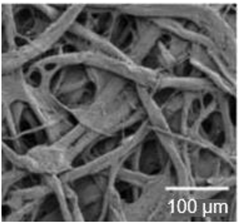 |
Smooth surface; almost consists of pure cellulose; no other impurities; superior aperture; the thickness and structure are relatively uniform. |
| Nanocellulose paper. Reprinted with permission from [100]. Copyright 2016: American Chemical Society. | 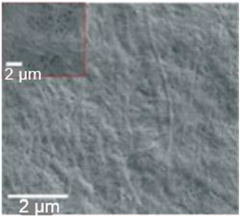 |
Dense structure; glaze surface; high grade of transparency; good hydrophobicity. |
| Anisotropic, transparent paper. Inside the anisotropic transparent film showing aligned microfibers. Reprinted with permission from [101]. Copyright 2017: Wiley-VCH. | 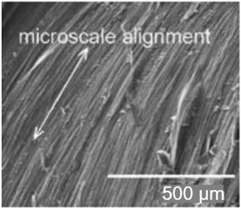 |
Anisotropy; high transparency; high mechanical tensile strength. |
| Nitrocellulose paper. Reprinted with permission from [102]. Copyright 2020: Elsevier B.V. |  |
Excellent biocompatibility; unique physical and chemical properties; the ability to immobilize various biomolecules. |
| Transparent microcrystalline cellulose/polyvinyl alcohol paper. Reprinted with permission from [103]. Copyright 2020: American Chemical Society. | 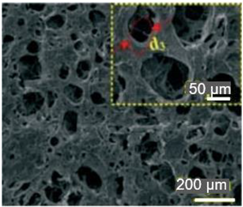 |
Adjustable aperture; high light transmittance (>95%); good mechanical properties; excellent biocompatibility |
Table 2. Comparison of cellulose nanopaper, traditional paper, and plastic.
| Characteristics | Cellulose Nanopaper | Traditional Paper | Plastic Paper |
|---|---|---|---|
| Surface roughness (nm) | 5 | 5000–10,000 | 5 |
| Porosity (%) | 20–40 | 50 | 0 |
| Pore size (nm) | 10–50 | 3000 | 0 |
| Optical transparency at 550 nm (%) | 90 | 20 | 90 |
| Max loading stress (MPa) | 200–400 | 6 | 50 |
| Coefficient of thermal expansion (CTE) (ppm K−1) | 12–28.5 | 28–40 | 20–100 |
| Printability | Good | Excellent | Poor |
| Young modulus (GPa) | 7.4–14 | 0.5 | 2–2.7 |
| Bending radius (mm) | 1 | 1 | 5 |
| Renewability | High | High | Low |
Table 3. Comparison of properties and cost for classical printed electronics substrates (plastic and conventional paper) and cellulose nanopaper.
| Parameter/Material | PET | Conventional Paper | Cellulose Nanopaper (Based NFCs) |
Cellulose Nanopaper (Based TEMPOCNFs) |
|---|---|---|---|---|
| Surface Roughness (nm) | ≈0.5–2 | ≈10 | ≈2–40 | ≈0.2–0.5 |
| Young modulus (GPa) | ≈2–2.5 | ≈2 | ≈10 | ≈10–13 |
| Coefficient of thermal expansion (ppm K−1) | 50–200 | — | ≈8–13 | ≈7.2–7.9 |
| Paper Transparency | Yes | No | Yes | Yes |
| Price (€ m−2) | 4–6 | 6–7 | 15–200 | 200–500 |
| Scale-up | Yes | Yes | No | No |
2.2. Advantages and Limitations of Paper-Based Substrates
Paper-based sensors are considered to be a new alternative technology for making simple, low-cost and flexible electronic devices [26,70,71,74,105]. In particular, the unique properties of paper [106,107,108,109], such as its versatility, commercial availability, high quantity, low cost, small thickness, high porosity, adequate biocompatibility for bioassays, high thermal stability for robust applications, high mechanical strength to resist wear and tear, and elevated Young’s modulus values make also paper a promising sensor platform for the development of portable and disposable analytical devices for many applications, including clinical diagnostics, food quality control, and environmental monitoring [73,110,111]. For example, already in the early 20th century paper began to be used in chromatography [112], and in 1956 the first paper-based sensors were developed [113]. It was device for the semi-quantitative detection of glucose in urine. Since then, such detection devices have been further developed. Paper-based pregnancy tests were developed [114], and in 2007 a paper-based microfluidic device [115] was developed that could simultaneously detect both glucose and protein in artificial urine. Compared to the substrate materials of other microfluidic detection platforms, the paper used in these devices has the advantages of low cost, flexibility, and the ability to passively transport fluid due to capillary action [116]. In addition, the various properties of paper, such as thickness, porosity, roughness and wettability, make it possible to precisely regulate the microfluidic behavior to meet various requirements [117]. Cellulose fibers can also be chemically functionalized, in other words the properties of wood cellulose fibers such as hydrophilicity, permeability, reactivity, etc. can be tailored according to specific applications [110]. Comparative characteristics of paper and the most common substrates used in the development of humidity sensors are given in the Table 4.
Table 4. Comparison of cellulose paper with traditional materials as substrates.
| Property | Material | |||
|---|---|---|---|---|
| Glass | Silicon | Polydimethylsiloxane (PDMS) | Cellulose Paper | |
| Surface profile | Very low | Very low | Very low | Moderate |
| Flexibility | No | No | Yes | Yes |
| Structure | Solid | Solid | Solid, gas permeable | Fibrous |
| Surface-to-volume ration | Low | Low | Low | High |
| Fluid flow | Forced | Forced | Forced | Capillary action |
| Sensitivity to moisture | No | No | No | Yes |
| Biocompatibility | Yes | Yes | Yes | Yes |
| Disposability | No | No | No | Yes |
| Biodegradability | No | No | To some extent | Yes |
| High-throughput fabrication | Yes | Yes | No | Yes |
| Functionalization | Difficult | Moderate | Difficult | Easy |
| Spatial resolution | High | Very high | High | Low to moderate |
| Homogeneity of the material | Yes | Yes | Yes | No |
| Price | Moderate | High | Moderate | Low |
| Initial investment | Moderate | High | Moderate | Low |
During the research and use of paper, it was found that the three-dimensional porous structure throughout the thickness of the paper with a large surface area makes it easy to absorb functional reagents, and, most importantly, allows selective processing of two sides of the paper with different or the same functions [118]. In addition, cellulose, which is insoluble in classical organic solvents, gives paper excellent chemical stability [119]. Paper consisting of only cellulose also exhibits higher dimensional stability with temperature change and lower thermal expansion than most plastics [120], which is advantageous for electronic components since the use of paper does not introduce complex thermal parasitic effects into the behavior of electronic devices.
Paper as a dielectric material can be used in numerous sensing devices, especially capacitive-type sensors. In addition, the unique three-dimensional hierarchical architecture of cellulose fibers with different length scales allows the accommodate various active materials in substrates, opening up great opportunities for the development of advanced electronic devices. In this regard, in recent years, research has been carried out aimed at studying the possibilities of using paper substrates for the development of various sensors [121,122,123]. PB sensors such as gas sensors [26,29], temperature sensors [124], all-paper piezoresistive sensors for human motion detection [125], nanocellulose paper sensors for multichannel biological detection [126], pressure sensors [125], humidity sensors [26,29,127] and strain gauges [26] were developed. In addition, paper can be made thin, lightweight and flexible depending on its pulp processing. In addition, paper is combustible and biodegradable material, which greatly simplifies the recycling process [128]. It can be easily stored, transported and disposed [72]. Widely established as a recyclable material, paper products have a recovery rate of about 70 percent. According to a report by the United States Environmental Protection Agency on municipal solid waste (MSW), in the United States, paper waste constitutes 27.4% of the total MSW. However, the MSW recovery is dominated by paper at 51% [129]. The paper recycling process has significantly matured over the past decades. It saves tremendous amount of energy and reduces deforestation.
Moreover, cellulose fibres can be functionalized, thus changing properties such as hydrophilicity, if desired, as well as its permeability and reactivity [130]. The surface of the paper can be easily manipulated by changing the printing conditions, coating and impregnation. In addition, it can be produced in large quantities. Depending on the main goal to be achieved in paper-based sensors, the fabrication methods and the analysis techniques can be tuned to fulfill the needs of the end-user. For example, it has been reported that by filling inter-fiber space using transparent materials with reflective constant that is closed to the cellulose (≈1.5), it is able to fabricate transparent papers [74]. Reducing the diameter of cellulose fibers from micro-meters (≈20 μm) to nanometers (≈20 nm) will increase paper transparency [105].
Of course, paper substrates are inferior to plastic ones in terms of mechanical strength, resistance to aggressive environments, and manufacturability. The inherent surface roughness and porosity complicate the fabrication of devices on paper, especially when their size is reduced. However, there are paper processing methods that can significantly improve the properties of its surface [131]. For example, it has been shown that laser ablation [132] can be used to improve paper surface morphology and change surface energy, and plasma polymerization can be used to create hydrophobic polymer chains on the paper surface to make it water repellent [133]. Other interesting examples include the ability to improve the hydrophobicity of a paper surface by coating with organic or inorganic nanoparticles [134,135,136].
In addition, the large pore size in the paper results in poor thermal performance [137]. Moreover, cellulose itself is also prone to decomposition at temperatures above 100 °C [138,139,140]. Excess heating easily warps papers and degrades the quality of the cellulose structure. The upper limit of temperatures used for curing must be lower than 150 °C for a short period (such as 10 min). The degradation of cellulose results in a reduction in the mechanical strength of the paper [141]. This means that paper-based sensors are low temperature operated devices, and paper cannot be used in the high temperature processes often used to deposit humidity sensitive materials. This severely limits the types of deposition processes that can be applied to paper and the number of sensitive materials that can be used in PD humidity sensors.
Ongoing research also shows that paper substrates cannot replace plastic ones in all devices. But, in specific applications, paper substrates can undoubtedly find applications. For example, the high porosity of the paper makes it possible to incorporate materials that have properties that are important for sensor applications, but which are difficult to fix on plastic substrates. In addition, continuous pore channels, allowing for efficient diffusion of gaseous molecules throughout the film matrix, provide maximal exposure of sensing material to the gaseous analytes and thus makes it possible to enhance the sensor signal and accuracy [142].
Yao et al. [75], Hu et al. [143], and Singh et al. [144] believe that paper-based devices provide an inexpensive technology for fabrication of simple and portable diagnostic systems that can be immensely useful in resource-limited settings. The use of paper-based sensors will allow low-income regions to significantly expand the range of medical services provided at a low cost. Standard medical tests performed in centralized laboratories are either not available in such countries or are too expensive for most citizens. At the same time, paper-based sensors, inexpensive and easy to operate, could be used in resource-limited environments. Paper-based detection platforms also have great potential for use in remote areas and during emergency situations, where fully-equipped facilities and highly trained medical staff are absent.
2.3. Paper Selection
As we can see, there are a variety of paper materials available to the user. However, it cannot be said that paper of all types is a universal material suitable for all applications. Different types of paper have different properties and therefore the choice is based mainly on the fabrication steps required in developing a device and also on the specific application area [108,110,145,146]. In particular, the filter paper (the Whatman® cellulose range, Maidstone, UK) is most suitable for developing microfluidic sensors due to its wicking ability [147]. The range of Whatman® filter papers is popular due to the choice of paper with the required porosity (pore size of 11–25 µm) to control particle retention and flow rates [148,149]. The difference between paper grades lies on the coarseness and packing of the cellulose fibres. Different grades allow different sampling and assay settings to be applied. Due to the porosity of Whatman® filter papers, flow rate, and particle retention, this paper is suitable for fabricating electrochemical devices capable of storing the reagents, filtering the sample, enabling reactions to occur, and flowing the detectable product towards the electrochemical testing area [150]. Paper towel also has properties similar to filter paper. Paper towel is cheaper than filter paper and possesses a high porosity, which makes it a viable material for analysis of a wide range of analytes [151,152].
Nitrocellulose, obtained from the partial nitration of cellulose, enhances the porous property of cellulose and changes the material from hydrophilic to hydrophobic due to the presence of nitro groups. It has smaller pores than those of Whatman Grade 1 paper. Nitrocellulose membranes exhibit a high degree of non-specific binding towards biomolecules and are suitable for immobilization of enzymes, proteins and DNA [122,153]. In addition, nitrocellulose membranes are smooth and have a reasonably uniform pore size, which results in a more stable and reproducible liquid flow within the paper. This makes hydrophobic nitrocellulose suitable for the development of various biosensors. Bioactive paper has also been used in biosensors. In the bioactive paper, the paper matrix is modified with biomolecules. This facilitates the adsorption of biomolecules. One of the challenges of using nitrocellulose is related to the difficulty of working with this paper because it is fragile and difficult to handle. In addition, the oxidation of nitro groups is observed [109]. These shortcomings have significantly limited the use of this paper.
We must not also forget about office paper. The structure of office paper can be used in various configurations. For example, due to the non-degradability and relatively smooth surface of glossy paper, it is a good substitute for filter paper especially when modifying nanomaterials onto a surface rather than within the fibre matrix is necessary [154]. In addition, due to the lower porosity of the office paper, electrodes can be formed directly on the surface without penetrating deep into the paper. Moreover, the ordinary A4 printing paper has been found to be the most widely used for making PB flexible humidity sensors due to its good mechanical flexibility, rough and porous structure, good hydrophilicity, and easy availability [26]. Santhiago et al. [155] showed that it is possible to develop wearable devices based on office paper, which should be foldable and flexible. Chromatographic filter paper has high fragility after wetting
Conventional paper is known to have disadvantages such as optical opacity, high surface roughness, and low mechanical strength and low stability in aqueous media, which may hinder further development of paper-based sensor devices for special applications [122,156]. On the other hand, it has been found that nanopaper, mainly made from densely packed renewable natural nanomaterials, not only has many of the advantages of conventional paper, but also eliminates many of its disadvantages, offering much higher transparency, better chemical, thermal and mechanical stability, much lower thermal expansion and lower surface roughness [156,157]. Besides, nanopaper maintains its structure in the aqueous media, compared with conventional paper. This makes nanopaper an excellent platform for the production of high-performance paper-based sensors [158]. The potential application of nanopapers for humidity sensing was reported by Li et al. [159]. Giese et al. [160] developed cellulose nanopapers undergo rapid and reversible changes in color upon swelling, which show potential applications in humidity sensing. Nogi et al. [161] used cellulose nanopapers with a high surface smoothness as a substrate for the antenna to transmit and receive signals, which is an important component of a satellite, computer, or other radio-frequency identification (RFID)-based devices. As for the disadvantages of cellulose nanopaper, they usually include the following [162]: (i) poor retention in fibrous materials; (ii) relatively high cost; (iii) negative effect on paper drainage and drying, (iv) increased tear susceptibility, and (v) high energy consumption in production. This is what limits the widespread use of cellulose microfibers (CNFs)- and cellulose nanocrystals (CNCs)-based substrates for the development of cheap flexible humidity sensors.
In addition to the examples above, unusual paper substrates such as carbon fiber paper (CFP) and paper hybrids can be found in paper-based sensor designs. Carbon fiber paper is a composite paper composed of carbon fibers and polymeric carbon. Its production process begins with polymerization and carbon fiber formation, followed by carbonization, papermaking, resin impregnation, molding, and a final heat treatment step [163]. CFP has been primarily explored as a building material for electrodes, due to its exceptional conductivity, high chemical stability, and good mechanical properties. Limitations of CFP include low electrochemical activity and small surface area [164]. It has been reported that cardboard can also be used as an alternative to paper. Its use was first proposed in [165], where laser pyrolysis of organic compounds present in cardboard formed a highly ordered graphite-like structure used as a conductive electrode.
A discussion of the advantages of certain types of paper for the development of flexible devices can be found in published reviews. In particular, Liu et al. [71] summarized the diverse paper substrate options and fabrication techniques for PB electronics. Barhoum et al. [83] and Naghdi et al. [158] reviewed the flexible and multifunctional nano-papers and analyzed their possible applications. Zhang et al. [70] reviewed the micro/nanostructured papers as substrates for flexible electronics. Mahadeva et al. [166] considered paper as platform for energy and sensing applications.
As follows from this consideration, the mechanical, chemical and electrophysical properties of each paper type differ from each other due to differences in the material composition and manufacturing processes. As a result, it is hard to generalize a set of properties for paper as the constituents of paper vary among different types of paper [72]. For example, printing paper has some cellulose fiber with a large amount of filler material. The filler material can either be natural materials (limestone, clay, and talc) or synthetic alternatives (precipitated calcium carbonate, titanium dioxide, and gypsum). The quantity and type of filler materials define the structure, thickness, and appearance of the paper [167]. The filler dictates the cost of production, refractive index, paper strength, brightness, energy required for drying, friction, pore size, and burn rate of the paper [168,169,170]. Fillers can negatively affect the strength, retention, abrasion, dusting, and sheet two-sidedness. Thus, the diversity in the types and quantity of filler material used in each type of paper is what makes the properties of paper (in general) so diverse. This has remained a challenge for researchers to theoretically identify the properties of the paper which they used in their research.
This entry is adapted from the peer-reviewed paper 10.3390/nano13061110
This entry is offline, you can click here to edit this entry!
